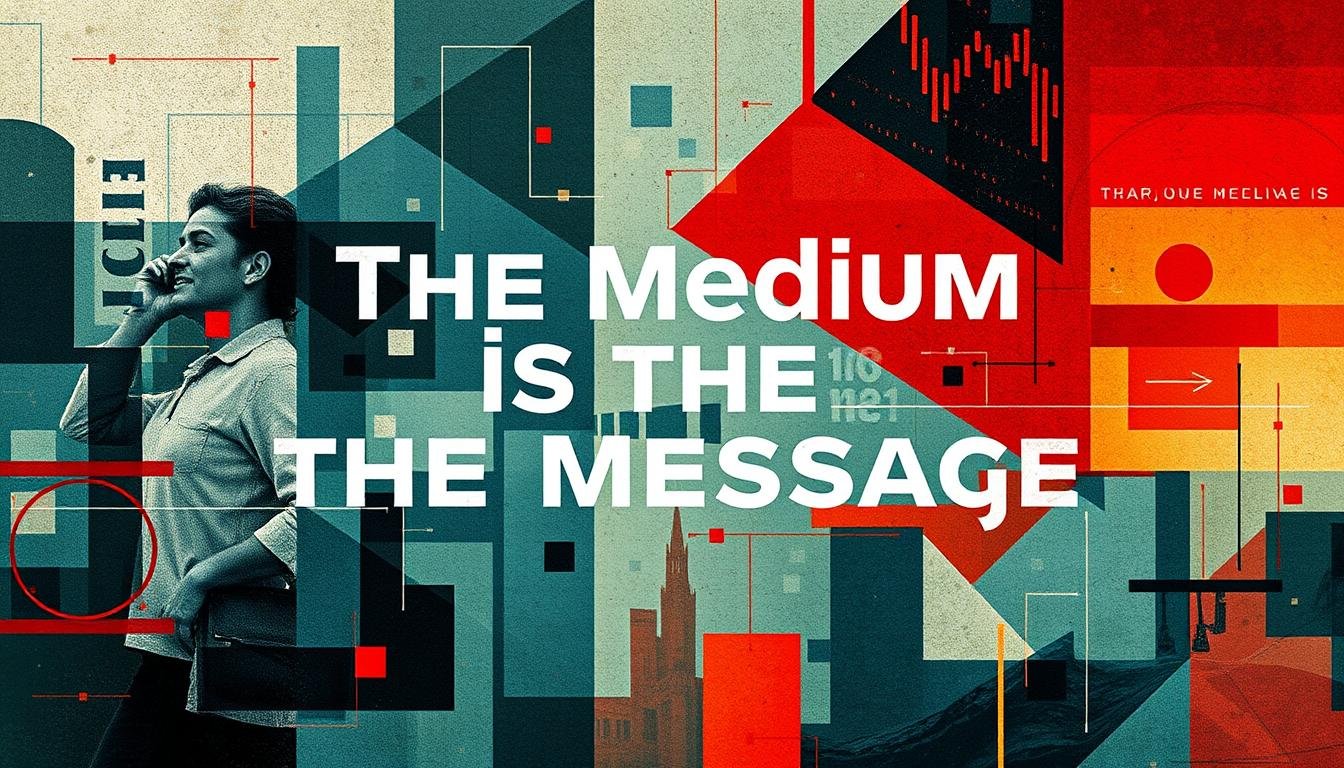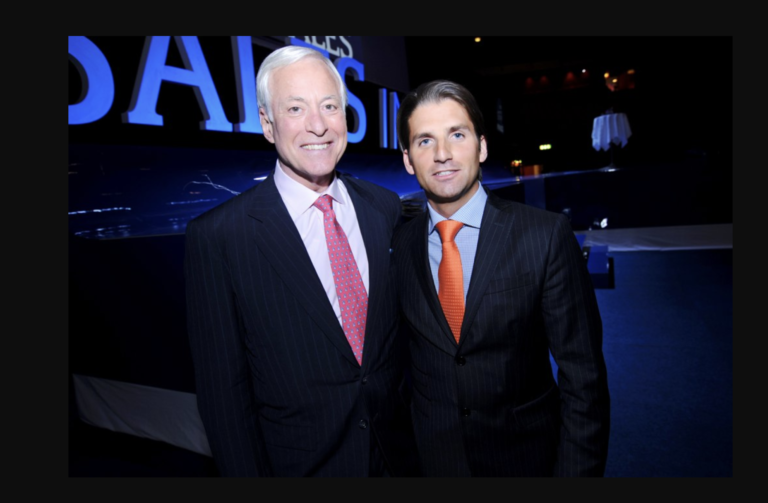Marshall McLuhan: The Medium Is the Message – Media’s Role in Marketing
Imagine a world where a single light shines brightly in a dark room. This light is not just for illumination, but a statement that grabs attention. Marshall McLuhan’s idea, “the medium is the message,” changed how we see the world. He showed us that the medium shapes our experiences and perceptions.
McLuhan said it’s not the content that matters, but the medium itself. This idea has changed marketing and how we connect with people. Today, marketers know that the medium affects how their messages are received. They use this knowledge to make sure their brand stands out in a crowded media world.
Let’s dive deeper into how McLuhan’s ideas apply to marketing and media. He believed that choosing the right medium can change how people see and interact with brands. This means marketers need to think about the media they use to tell their brand’s story. Join us as we explore the link between media and marketing, inspired by Marshall McLuhan’s vision.
Introduction to Marshall McLuhan’s Theory
Marshall McLuhan, a Canadian professor and philosopher, changed how we see media’s impact on marketing and communication. He said, “the medium is the message,” which changed our view of mass media. This idea is still important today, especially with the Internet.
Who Was Marshall McLuhan?
Marshall McLuhan was all about understanding how communication tools change how we see the world and culture. He talked about a “global village,” showing how technology connects us across distances. He even predicted how the Internet would change how we access and share information.
The Origins of “The Medium Is the Message”
McLuhan believed that the way we get a message is more important than the message itself. He said that each medium, like TV, print, or the Internet, changes how we understand and connect with messages. His ideas are still used in marketing and communication, showing the power of matching the right medium with the message.
The Relevance of McLuhan’s Theory Today
McLuhan’s ideas are still important today, with social media, email, and videos changing how we get and understand information. For example, Twitter is great for short messages, while YouTube is better for longer videos. Interactive content, like live streams, really gets people involved.
Digital marketers should remember McLuhan’s advice. They should make sure their messages work well across different platforms and fit the situation. With new tech like virtual reality and AI, marketers can share messages in ways that might have amazed McLuhan. Understanding how media affects marketing is key to building trust with customers.
The Medium Affects Message Reception
In today’s digital world, knowing how the medium and message work together is key. McLuhan showed us that the way we send a message changes how people receive and understand it. It doesn’t matter if it’s old media or new; matching the message with the medium is crucial for clear communication.
Medium vs. Message: An Intricate Relationship
The link between the medium and the message is deep and powerful. New Media, for example, combines text, video, pictures, and music and is very interactive. This lets marketers connect with people using devices like laptops, tablets, and smartphones. By using smart digital marketing, companies can avoid mistakes like Burger King’s failed campaign on International Women’s Day.
Transformative Impact on Consumer Perception
The way the medium changes how people see things is huge. As media in marketing keeps changing, it’s important to know how different platforms affect people’s engagement and understanding. McLuhan’s ideas show that New Media goes beyond old ways by offering real-time talks, breaking language barriers, and crossing distance gaps. This new way includes things like Bitcoins and changes how we do business. So, digital marketing plans need to match the medium and what the audience likes to make sure the message gets through and save resources.
Marshall McLuhan’s ideas are still key to understanding how the medium shapes what people think and do. By matching messages with the right media, businesses can really boost their marketing.
Media Channels in Marketing Communications
Choosing the right media channels is key in today’s fast-paced marketing world. It affects how well a brand’s message reaches its audience and its overall reach. In 2004, the State of the Media report showed that half of U.S. households got a daily newspaper, with an average of 1.9 magazine subscriptions per person. This highlights the lasting impact of traditional media even with the growth of digital options.
Now, marketing plans must include many digital platforms. Social media, email, video, and podcasts each have their own benefits and require specific strategies. Using these platforms well can greatly increase the effect of advertising and media influence. It ensures messages are not just seen but also interacted with in a meaningful way.
Also, digital marketing must keep up with how consumers behave today. A 2008 study from the University of California, San Diego, found that U.S. households consumed about 3.6 zettabytes of information, a 350% jump since 1980. This shows the need for marketers to be smart in choosing their channels to stand out.
New technologies are also opening up new ways to connect with audiences. Virtual reality and AI-driven experiences are creating new paths in brand communication. These tools allow for immersive and personalized marketing. They offer a new way for brands to deeply connect with their audience, boosting their advertising and media influence.
Finally, combining different media channels and new digital marketing strategies is crucial. As media keeps changing, marketers need to stay flexible. They must always adapt to use the best of traditional and digital channels to share their brand messages well.
Digital Marketing Strategies and McLuhan’s Insights
Marshall McLuhan’s idea that “the medium is the message” is key in digital marketing. It means making sure the message fits the platform used. This makes the message more effective and reaches more people.
Adapting Content for Different Platforms
It’s important to know each digital platform’s unique nature. For example, Twitter needs quick and timely updates because of its 275 million users. LinkedIn, with 546 million users, wants more detailed, industry-focused content. This shows how marketing and technology work together to shape strategies.
McLuhan believed that new media change us more than the content they carry. Digital marketers use this idea to make their messages fit each platform. This boosts engagement and makes the message more effective.
The Role of Social Media in Modern Marketing
Social media is key in today’s marketing. Facebook reaches a wide audience, while Instagram and Snapchat focus on visuals. Videos are big, with 72% of B2B buyers watching them before buying. This proves McLuhan’s point that the medium shapes how we see the message.
Impact of New Technologies
New tech keeps changing how marketing and technology work together. VR and AR are becoming big for immersive marketing. McLuhan’s ideas suggest these new tools will change how we connect with customers. This means marketers need to use these technologies to make deeper connections.
| Platform | Reach | Content Type |
|---|---|---|
| 275 million monthly active users | Concise, timely updates | |
| 546 million professionals | Industry-relevant content | |
| Greatest social media reach | Broad audience engagement | |
| YouTube | 72% B2B buyers prefer video | Product demonstrations, testimonials |
Communication Theory in Advertising
McLuhan’s ideas are key in advertising. The medium greatly changes how the consumer gets the message. He says the medium changes and shapes the message, not just sends it.
Companies like Google and The Gates Foundation use the OKR framework. They set clear goals in writing. This shows how written communication makes goals clear and measurable. It proves McLuhan right, as the medium (writing) shapes the message.
The People’s Choice Study in 1940 is another example. It looked at how political campaigns affect voters. More media exposure made voters stick with their choice, while undecided ones looked to others. This shows how media can change how we decide, supporting McLuhan’s theory.
Looking at societies with written and spoken laws also shows McLuhan’s point. Written laws last longer and help bigger areas. This is like how written communication helps societies grow.
The *Double-Loop* project highlights the importance of how we share ideas. It shows how the medium affects how we understand and remember messages. This is key to applying McLuhan’s marketing ideas.
Finally, the Agenda-Setting and Uses and Gratifications Theories are important too. They say media sets the public agenda and people use media for different reasons. These ideas match McLuhan’s view that media shapes not just the message but how we see and act on it.
| Medium | Impact | Example |
|---|---|---|
| Written Laws | Permanence and Stability | Societies able to scale across larger areas |
| Interpersonal Communication | Building Trust and Guidance | Undecided voters seeking more personal advice |
| OKR Framework | Clear Goal Setting | Adopted by Google and The Gates Foundation |
Knowing how the medium changes the message is key for good ads. By using McLuhan’s ideas, marketers can make ads that really connect with people.
Impact of Media on Consumer Behavior
Media has a big impact on how we make choices and see brands. From TV to Instagram, different media shapes how we interact with products. It’s key for marketers to grasp this to make good strategies.
Influence of Different Media on Decision-Making
Social media greatly affects how we decide. 64% of U.S. adults think social media hurts democracy and 65% say it makes political divisions worse. Also, lies on Twitter are 70% more likely to spread than truths. This shows how media and ads shape our views.
Teens spend over 3 hours a day on social media, which can make them more likely to feel depressed and anxious. This shows how media can affect our feelings and actions.
Case Studies: Successful Media Strategies
Case studies show how media changes consumer behavior. For example, Facebook and Twitter make most of their money from ads. Stars like Derek Jeter and Bono help shape what we value, affecting our choices of brands.
Studies link watching a lot of sexual content in media to early sexual activity in teens. This shows how media can guide our choices early on. Traditional media also keeps up cultural values, sometimes keeping stereotypes alive, which affects what we prefer and do.
Good media strategies tap into our feelings and gut reactions. They use ads, influencer partnerships, or targeted content. Knowing how media, consumer behavior, and ads connect is key for today’s marketers.
Technology and Marketing: An Evolving Field
The world of technology and marketing is always changing. New tech moves fast, affecting how brands market themselves. It’s key to use the latest tools to stay ahead. Understanding how these innovations help make marketing work better is crucial.
Role of Emerging Technologies
Technologies like VR, AI, and AR are changing technology and marketing. They let brands connect with people in new ways. For example, VR takes people into a product’s world, and AI uses data to make marketing more personal.
Innovative Marketing Campaigns Using New Media
These new techs help create innovative marketing campaigns that grab attention. Brands like Nike and Coca-Cola use AR in their ads for a fun, interactive experience. As these tools get easier to use, marketers should use them to make campaigns that really speak to people.
Marshall McLuhan: The Medium Is the Message – Media’s Role in Marketing
Marshall McLuhan’s idea of “the medium is the message” is key to grasping media’s impact on marketing. It shows how the way we share messages changes how people receive and understand them. Today, as we use more digital media, McLuhan’s ideas are still very useful.
Now, over 70% of ad budgets go to media buying, showing how important the medium is. The media world has grown to include digital and mobile, not just old-school TV and newspapers. In Nigeria, 70% of internet use is on mobile phones, showing a big move to mobile media.
Marketers have many ways to reach people, like digital, mobile, and even in-person events. For example, BookTok on TikTok got over 70 billion views, proving some platforms can really get people talking. This helped Indigo sell more books through a popular online club.
TikTok also tells brands to work with content creators and use trending hashtags to get better results. A great example is AHI’s album “Prospect,” which got a lot more attention than their past work, thanks to TikTok. Another example is a clothing ad that matched messages with the weather, really connecting with people in certain places.
In the end, Marshall McLuhan’s ideas are still very important for marketing. They remind us that the medium is the message. By knowing this, marketers can make their messages work better in our complex media world.
Understanding Cross-Media Consistency
Cross-media consistency is key to a strong brand story across different platforms. It makes sure every touchpoint matches the brand’s message. This builds trust and recognition with customers.
Ensuring Unified Brand Messaging
Marshall McLuhan showed how important it is to have a unified brand messaging strategy. His ideas, like “the medium is the message,” help us today, even with social media on mobiles. A study looked at 100 tweets and 100 Flickr photos daily for a week. It found that a consistent brand message on these platforms boosts engagement and loyalty.
The Significance of Visual and Language Consistency
Being consistent in visuals and language is crucial for cross-media consistency. On Twitter and Flickr, the study proved McLuhan right—how we see the message matters. Tweets and blog posts may differ, but they should always share the brand’s core values. This approach creates a strong, trustworthy brand.
Using cross-media consistency, brands use each platform’s strengths while keeping a single brand message. This strategy, based on McLuhan’s ideas, makes a brand more recognizable and trusted by consumers.
Conclusion
Marshall McLuhan’s famous saying, “the medium is the message,” has deeply influenced how we see media’s effect on marketing. He first shared this idea in “Understanding Media: The Extensions of Man” in 1964. He believed that the way we get content shapes how we see and understand the message.
This idea is key in media ecology and has become more popular with the internet’s rise in the 1990s. It shows us that the medium is just as important as the message itself. Over time, media has changed from radio and TV to cable and online streaming. This change affects how people act and how marketers plan their strategies.
Social media like Facebook, Instagram, and Twitter have changed how we interact with each other. They show how McLuhan’s ideas are still right. Each medium changes society and our lives in its own way.
Today, McLuhan’s ideas are crucial for making smart marketing plans. It’s not just about using new tech; it’s about applying his principles thoughtfully. By doing this, marketers can make messages that really connect with people. This shows the lasting truth of “the medium is the message.”
Source Links
- The medium is the message
- Marshall McLuhan, “The Medium Is The Message” – Theories Every Careers Adviser Should Know
- The Medium Is The Message
- Applying “The Medium is the Message” Theory to Marketing Today
- New Media, An Academic Perspective
- 2.2 Media Effects Theories | Media and Culture
- 2.5: Media Messages
- 1.3 The Evolution of Media
- Communication as Change: Marshall McLuhan and a Transformation Model of Communication
- How ‘The Medium is the Message’ with Social Media
- Marshall McLuhan: "The Medium is the Message"
- With Strategy, the Medium is the Message
- If the Medium is the Message, What Message Is Social Media Sending? – Post Control Marketing
- 2.2 Media Studies Theories
- Is the Medium Still the Message?
- Marshall
- THE MEDIUM IS THE MESSAGE
- When Media Is Everywhere, Is The Medium Still The Message?
- McLuhan’s Relevance in Today’s Society: A Look at Social Media on Mobile Devices
- Counting Electric Sheep: Understanding Information in the Context of Media Ecology
- The Medium and McLuhan’s Message
- The medium is the message: Marshall McLuhan saw the catastrophe coming – Pearls and Irritations







